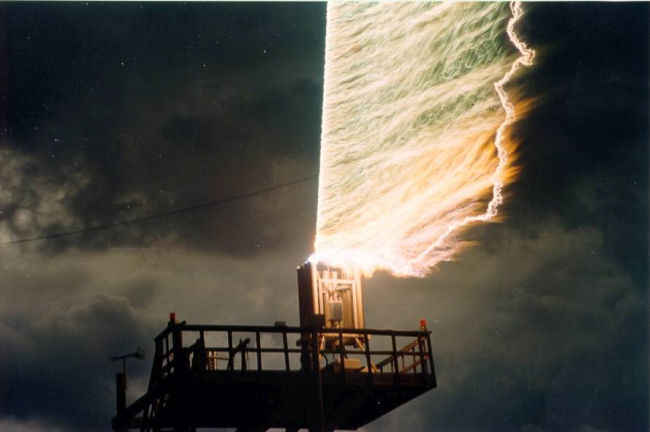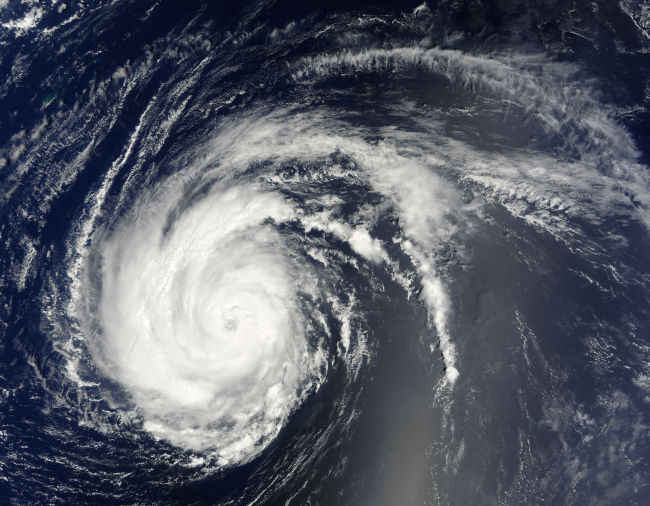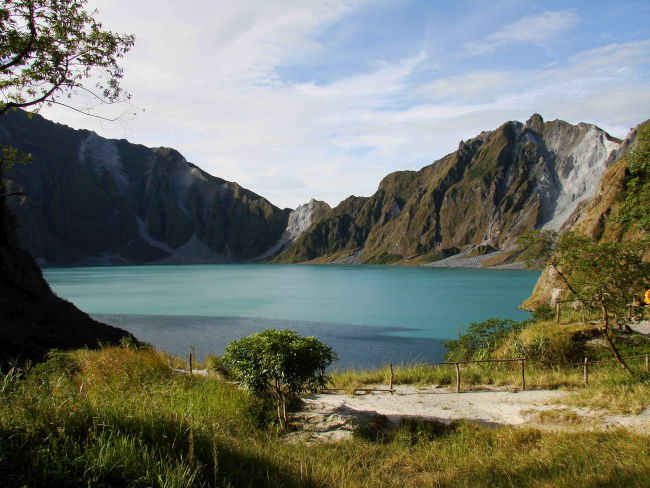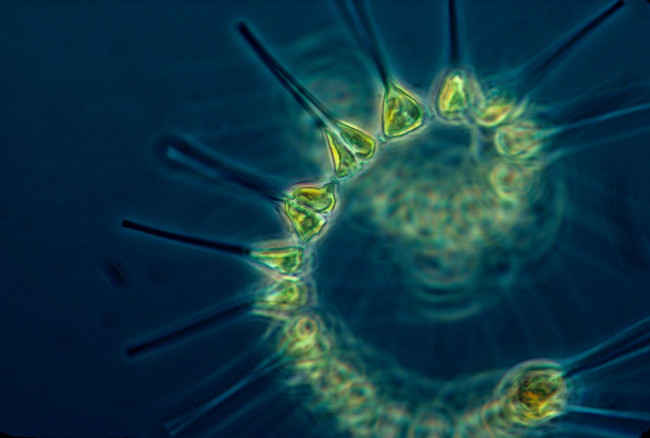3 ways science can help us control the weather
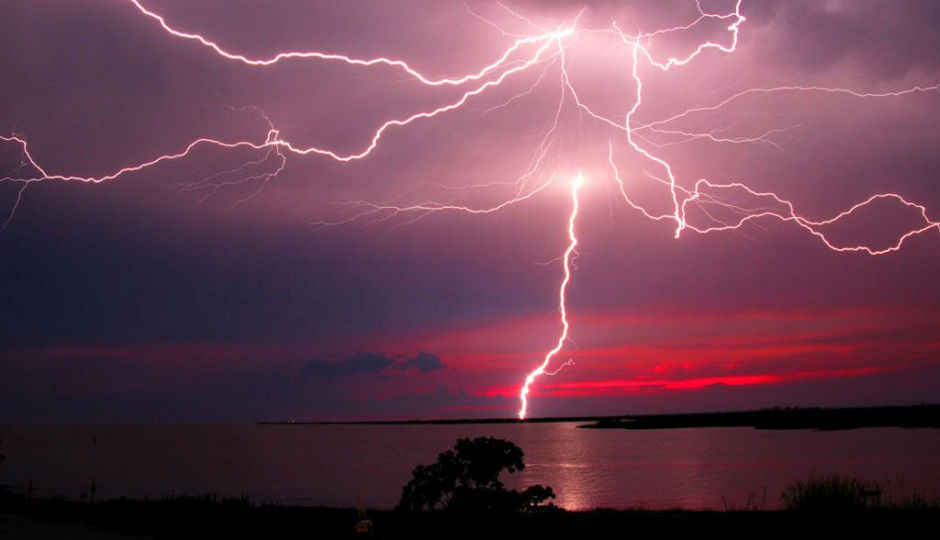
Humans will always find a way to mould things around us to suit us, and that is why we are awesome, and that is also probably why we are hated (by hyper intelligent animals who can understand such complex emotions). Glow in the dark rabbits? Poisonous cabbage? Tosh! We’ll take you through some of the more interesting, and philosophical-question-raising ideas that scientists around the world have come up with to make our earth a better place.
Dial-a-lightning
In what would make a very good slowmotion video, all scientists at the University of Florida have to do is fire a rocket with a trailing grounded copper wire attached to it into a thundercloud, and after traveling around 600-900 feet–lightning strikes. The special wire inside the three foot long rocket distorts the electric field under the cloud, resulting in a lightning discharge hitting the rocker. All of this occurs with the team behind it cosy in a metallic trailer that is completely grounded. The alternative, is to hope that lightning falls exactly where you want it to. The main scientist behind this, Dr. Rakov and his colleagues use this technique to test to what extent devices like electric lines, insulation on nuclear weapons, and airport runway lights can withstand such a hit.
Rocket-triggered lightning at the University of Florida
But this is when you want lightning to hit something. There are also ways to make lightning go somewhere else. While still in the test phase, the idea is of shooting a beam into the atmosphere that will leave a stream of ionized molecules in its wake, minus their electrons. This stream could be used to pull and channel lightning bolts. The only problem was that till now all of the research just allowed for this beam to travel a few feet at best, useless we would imagine unless you want that lightning bolt to hit “just a few feet away.” Now, courtesy University of Arizona and Florida, that beam can travel at least 165 feet, enough to avert a disaster. The new beaming method will involve embedding the primary high intensity laser beam into a secondary lower intensity beam, called the dress beam, which will refuel the primary beam and allow it to travel larger distances.
Ack! You say this was pretty straightforward. Where are the philosophicalquestion-raising ideas you spoke about? Yes yes we are getting to it, gradually.
Hurricane Repel
When they were not being helpful by destroying Mongol fleets when they were en-route to invade Japan 1274, or preventing England from being attacked by the Spanish Armada in 1588 by ramming right into the invaders, hurricanes cause billions of dollars of damage by destroying homes, leveling cities, and killing thousands. Yes there are methods now which ensure that hurricanes do not arrive unannounced, but there is only so much one can do in 48 hours, shifting an entire city not being one of the options. So what can we do?
Well between 1962 and 1983, a hurricane research program called Project Stormfury was implemented with a plan to cut off the air supply feeding the eye wall, the location just outside of the eye of the hurricane where the most damaging winds and intense rainfall is found. This would result in the eye wall fading away. After this, a second, wider eye wall would emerge further from out from the storm’s centre. It was expected that because this wall would be wider, the air whizzing into the clouds would be slower and thus less dangerous.
While the first two hurricanes it was tried on showed positive results, which may have caused some scientists’ beerglasses clinking, that high came off when the third hurricane showed only a insignificant impact, and the fourth hurricane no impact at all. It was later found out that the third hurricane would have acted the same way independent of the method used. So we were back to square one.
Hurricane Earl is glad turbines are not used yet
Now after considering placing a substance on the ocean surface which would prevent evaporation thus limiting intensity of the hurricane, dragging icebergs to the water surface to cool it since hurricanes’ energy feeds on warm ocean water, and even nuking the centre of the hurricane because we want to see what Fallout will look like in real life, scientists are now pondering another possible solution- wind farms.
The idea, by Stanford engineer Mark Jacobson, is to place wind turbines along the coast of an area which regularly sees hurricanes. When the winds go through the turbine blades causing them to spin, some of this kinetic energy gets converted to electric energy, thus causing winds to slow down by even around 50%. Thus in theory this can save lives and power your television too.The slow winds would even result in decreased flooding caused by hurricanes when it causes the waters along the coast to rise much higher than a normal tide, called storm surge, by up to 79%. One of the few issues which persist from Project Stormfury days are that it would still be difficult to understand the exact impact a wind-farm would have on a hurricane.
While Mark stated that a 100,000-turbine wind farm from New York to Washington would have reduced Hurricane Sandy’s winds by up to 140 kmph and reduced the storm surge we spoke about earlier by 34%. According to estimates, a 5-turbine farm would cost around $300 mil. So the Washington-New York wind farm would cost a whopping $6 trillion. That is the same amount the US will spend on its military campaigns on Iraq and Afghanistan.
Geo-engineering
Ah, here comes the questions-raising part. So Geo-engineering, fondly called ‘mad science’ by some sceptics or realists depending on what side you are on, is a purposeful large-scale manipulation of the Earth’s climate with the aim of reducing global warming. With ideas of Geo-engineering being around since 1953, the debate rages on what the implications of such an activity would be. Why the controversy? Well lets look at some of the methods which have sprung up to counter the menace of melting glaciers.
Dark Skies
The idea here is to throw sulphate particles into the stratosphere, which will reflect sunlight and reduce the temperature of the earth. This notion, which first arose in 1977, was given further weight when the eruption of Mount Pinatubo in the Philippines in 1991 threw up 20 million tonnes of sulphur dioxide into the stratosphere after which the entire planet cooled by 0.4 to 0.5°C.
The deadly eruption at Mt. Pinatubo in 1991
Possible repercussions? The sulphates may deplete some of the ozone layer, influence ecosystems by reducing the capacity of plants to undergo photosynthesis due to the reduced sunlight, result in the skies ceasing to be blue, and of course could be a ‘small’ contributor to acid rain throughout the world . A big responsibility.
But that didn’t stop Russian scientist Yuri A. Israel from carrying out field tests of this theory in 2009. The scientists set up detectors on the ground to measure meters like solar radiation, wind speed, pressure, temperature, and humidity. At 10:50 am, the Soviet Mikoyan-8 helicopter flew up 650 feet and went back and forth over a 3 mile long distance in the sky, perpendicular to the wind direction, releasing smoke. While the general cloudy conditions made it a bit of a pain to figure out whether any effect was natural or due to the foreign particles, the scientists soon realized that the smoke which they had released into the air had scattered up to 10% of the Sun’s rays at different points during the experiment.
David Keath, famous for his talks on the subject, argues that while geoengineering looks like an extreme step, the need for it will only increase as we continue to be unable to reduce carbon dioxide emissions. One of the reasons why geo-engineering is still not talked about in the open so much is because it promotes the notion that we don’t need to reduce our carbon emissions since we can just, you know, throw some sulphate into the air and we’ll be fine.
Another argument against releasing sulphates into the stratosphere is that it addresses only one issue of warming – which may also be just a symptom – without addressing the other pertinent issue of levels of carbon dioxide in the atmosphere. But we have a solution to that too.
Iron-seas
Mt. Pinatubo returns to help pro-climate manipulation scientists! When the volcano interrupted it also deposited around 40,000 tons of iron dust into the oceans. An environmental scientist studied the event and saw that it substantially brought down atmospheric carbon dioxide. So the next method of reducing carbon dioxide in the atmosphere is by dumping iron into the sea.
Mt. Pinatubo, caught in a rare moment of non-eruption
The reason? See Phytoplankton are these single celled organisms found in the sea. They absorb carbon dioxide from the atmosphere, convert it to energy, and when they die they take the hapless carbon dioxide to the bottom of the ocean, never to be heard of again. Iron promotes the growth of phytoplankton. Thus in theory more phytoplankton results in more carbon dioxide being sucked out from the atmosphere.
Phytoplankton are also suspected of being the reason the ice age lasted for so long. Researchers from Princeton University and Swiss Federal Institute of Technology in Zurich proved that dust borne by the wind carried iron to the region of the globe north of Antarctica, driving the growth of phytoplankton, leading to the removal of carbon dioxide from the atmosphere, thus amplifying the ice ages and making them much colder. Some even say there would have been no ice age on the planet at all if it wasn’t for this sucking out of carbon dioxide from the atmosphere.
So on October 23, 1993, a crew of scientists dumped almost 1,000 pounds of iron into the sea, mixed with a colorless chemical that would help the crew track the patch which was ’fertilized’. Sure enough, the next day the scientists swore they could even smell the phytoplankton growing. They had succeed in increasing
the growth of the helpful plankton, but unfortunately all they were able to record was a three-fold increase in chlorophyll levels, not nearly enough to be practical.
In June 1995, researchers once again dumped iron into the ocean, except this time they ensured that the iron stayed near the surface and received sunlight. After this the researchers saw 30-fold increase in chlorophyll levels. This consumed an estimated 367 tonnes of carbon dioxide.
Phytoplanktons will take care of the pesky CO2
So Iron fertilization might actually work after all. But hold on though, there were still quite a few hang-ups to address before we actually took to making the oceans look a little less blue:
There are still concerns that this method could actually increase the amount of carbon dioxide in the air. The iron could also cause Diatom blooms, a type of algae which has entered a – for lack of a better word – ‘blooming’ lifestyle, may actually take over the phytoplankton, thus destroying exactly what we are trying to promote. The result – whatever carbon dioxide is being absorbed now disappears as well. Should we be doing this at all then? See lightning kills around 53 people a year in the US alone. Hurricane Katrina killed 1,833 people. And the effects of global warming will cause entire cities to disappear under-water. While the idea of bending nature seems heavy handed, the point remains that there has come a point when man must put up a fight against nature to protect himself. The ideas are far from perfect, as we somewhat rightly guessed, but there is a strong need for them to be talked about, to be debated, because only then will we be able to figure out a solution to them if any.
Because, well, we respect nature and the earth and all that that entails, but when it comes down to the subject of life we would rather be on the side of the table which gives the orders.

